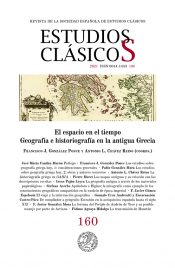EL VIAJE Y LA INFORMACIÓN GEOGRÁFICATravel and Geography
Francisco Javier Gómez Espelosín
Universidad de ALcalá
https://uah.academia.edu/JavierGomezEspelosin
https://www.uah.es/es/estudios/profesor/Francisco-Javier-Gomez-Espelosin/
Resumen
El viaje y los relatos derivados de él constituyen la fuente de información principal acerca del mundo exterior. La ausencia de un género de esta clase dentro de la literatura griega no impide comprobar su existencia y su papel en la configuración del saber geográfico. Los objetos exóticos y de lujo que aparecen en el mundo griego, especialmente en sus santuarios, escinden sus propias historias en este terreno, también desempeñaron un papel relevante en la confección de los periplos, y han dejado igualmente sus huellas en las digresiones geográficas de autores como Heródoto, que incluye además numerosas historias de viajes en el curso de su relato. Incluso desempeñaron un papel capital dentro de la geografía de gabinete como la de Eratóstenes y Tolomeo.
Palabras clave: Movilidad geográfica; relatos de viaje; objetos exóticos y sus historias escondidas; la integración de las noticias dentro de la tradición literaria
Abstract
The journey and the stories derived from it constitute the main source of informa-tion about the outside world. The absence of such a genre in Greek literature does not exclude its existence and its role in shaping geographical knowledge. The exo-tic and luxury objects that appear in the Greek world, especially in its sanctuaries, have their own stories in this field, they also played an important role in the ma-king of journeys, and they have also left their traces in the geographical digres-sions of authors such as Herodotus, who also includes numerous travel stories in the course of his narrative. They even played a major role in cabinet geography such as that of Eratosthenes and Ptolemy.
Keywords: Geographical mobility; traveller Tales; exotical and prestige goods and its hiden stories; adsortion of news in the literary tradition
Referencias bibliográficas
- Ampolo, C. & Bresciani, E. (1988) “Psammetico re d´Egitto e il mercenario Pedon”, en Egitto e Vicino Oriente 11, 237-253.
- André, J.-M. & Baslez, M.-F. (1993) Voyager dans l´Antiquité, París.
- Antonelli, L. (1998) Il Periplo nascosto, Padua.
- Betalli, M. (1995) I mercenari nel mondo greco. Dalle origini alla fine del V sec. A.C., Pisa.
- Betalli, M. (2013) Il mestiere delle arminel mondo greco antico, Roma.
- Bianchetti, S. (1999) “Reiseberichte”, en H. Sonnabend (ed.), Mensch und Landschaft in der Antike. Lexicon der historischen Geographie, Stuttgart-Weimar, 420-423.
- Bianchetti, S. (2013) “Il valore del racconto di viaggio nell´opera di Eratostene”, en K. Geus & M. Rathmann (eds.), Vermessung der oikoumene, Berín/Boston, 77-86.
- Boillet, P.-Y., Barat, C., Costanzi, M. (2012) Les diásporas grecques du VIII s. au III s. avant J.-C., París.
- Boshnakov, K. (2013) “The Sacred Counsel”: On Some Features of the Periegesis, Períodos, and their Originators”, en K. Geus & M. Rathmann (eds.), Vermessung der Oikoumene, Berlín-Boston, 25-64.
- Bouffier, S. (2012) (ed.) Les diásporas grecques. Du détroit de Gibraltar à l´Indus (VIII s. av. J.-C. à la fin du III s. av. J.-C., París.
- Brillante, S. (2020) Il Periplo di Pseudo-Scilace. L´oggetività del potere, Hildesheim.
- Capdetrey, L. & Zurbach, J. (2012) (eds.) Mobilités grecques. Mouvements, reseaux, contacts en méditerranée, de l´époque archaïque à l´époque hellénistique, Burdeos.
- Casson, L. (1974) Travel in the Ancient World, Toronto.
- Cunliffe, B. (1988) Greeks, Romans & Barbarians. Spheres of Interaction, Londres.
- De Angelis, F. (2020) (ed.) A Companion to Greeks across the Ancient World, Oxford.
- D´Ercole, M. C. (2012) Histoires méditerranéennes, Arlés.
- De Romanis, F. (2016) “An Exceptional Survivor and Its Submerged Background: The Periplus Maris Erythraei and the Indian Ocean Travelogue Tradition”, en G. Colesanti & L. Lulli (eds.), Submerged Literature in Ancient Greek Culture, Berlín/Boston, 97-110.
- Desanges, J. (1978) Recherches sur l´activité des méditerranéens aux confins de l´Afrique, Roma.
- Domínguez Monedero, A. J. (2007) “Mobilità umana, circulazione di risorse e contatti di culture nel Mediterraneo arcaico”, en A. Barbero (ed.), Storia di Europa e del Mediterraneo, I. Il Mondo antico, sez. II La Grecia, vol. III Grecia e il Mediterraneo dall´VIII sec. A.C. all´età delle guerre persiana, Roma,131-175.
- Dougherty, C. (1993) The Poetics of Colonization. From City to Text in Archaic Greece, Nueva York/Oxford.
- Garland, R. (2014) Wandering Greeks. The Ancient Greek Diaspora from the Age of Homer to the Death of Alexander the Great, Princeton.
- Giangiulio, M. (1996) “Avventurieri, mercanti, coloni, mercenary. Mobilità umana e circolazione di risorse nel Mediterraneo arcaico”, en S. Settis (ed.), I Greci. Storia.Cultura.Arte.Società, 2 Una storia greca I Formazione, Turín, 497-525.
- Gisinger, F. (1937) “Periplus (2)”, en RE XIX, 1, Stuttgart, 841-850.
- Gómez Espelosín, F. J. (1993) “Heródoto, Coleo y la historia de la España antigua”, Polis 5, 151-162.
- Gómez Espelosín, F. J. (1994) “Relatos de viaje en la Odisea”, Estudios Clásicos 106, 7-31.
- Gómez Espelosín, F. J. (2000) El descubrimiento del mundo. Geografía y viajeros en la antigua Grecia, Madrid.
- Gómez Espelosín, F. J. (2020) “En busca de un género perdido: El relato de viajes en la literatura griega”, en R. Nicolai & A.L. Chávez Reino (eds.), Tra geografía e storiografia, Sevilla-Alcalá de Henares,17-37.
- Gómez Espelosín, F. J. (2021) “Heródoto y los relatos de viaje”, Rationes Rerum 17, 27-40.
- González Ponce, F. J. (1995) Avieno y el periplo, Écija.
- González Ponce, F. J. (2008) Periplógrafos griegos I. Épocas arcaica y clásica I. Periplo de Hanón y autores de los siglos VI y V a.C., Zaragoza.
- Gunter, A. C. (2009) Greek Art and the Orient, Cambridge.
- Helms, M. W. (1988) Ulysses´Sail. An Ethnographic Odyssey of Power, Knowledge, and Geographical Distance, Princeton.
- Hofstetter, J. (1978) Die Griechen in Persien. Prosopographie der Griechen im persischen Reich vor Alexander, Berlín.
- Horden, P. & Purcell, N. (2000) The Corrupting Sea. A Study of Mediterranean History, Oxford.
- Hutton, W. (2016) “Travel Writing in the Ancient Mediterranean”, en C. Thompson (ed.), The Routledge Companion to Travel Writing, Londres, 101-111.
- Jacob, C. (1995) “Littérature et géographie en Grèce ancienne”, en E. Leonardy & H. Roland (eds.), Descriptions et creations d´espaces dans la littérature, Lovaina la Nueva, 11-29.
- Jacob, C. (1999) “Mapping in the Mind: The Earth from Ancient Alexandria”, en D. Cosgrove (ed.), Mappings, Londres, 24-49.
- Kaplan, P. (2006) “Dedications to Greek Sanctuaries by Foreign Kings in the Eight Through Sixth Centuries BCE”, Historia 55, 2, 129-152.
- Kaplan, P. (2008) “The Function of the Early Periploi”, CB 84, 2, 27-46.
- Kaplan, P. (2009) “Skylax of Karyanda (709)”, en I. Worthington (ed.), Brill New Jacoby
- Kopytoff, I. (1986) “The Cultural Biography of Things: Commoditization as Process”, en A. Appadurai (ed.), The Social Life of Things: Commodities in Cultural Perspective, Cambridge, 64-91.
- Kyriakidis, N. (2012) “Le sanctuaire d´Apollon Pythien à Delphes et les diasporas grecques du VIII au III s. av. J.-C., Pallas 89, 77-93.
- Kyrieleis, H. (1993) “The Heraion at Samos”, en N. Marinatos y R. Hägg (eds.), Greek Sanctuaries. New Approaches, Londres y Nueva York, 125-153.
- Kyrieleis, H., Röllig, W. (1988) “Ein altorientalischer Pferdeschmuck aus dem Heraion von Samos”, AM 103, 37-75.
- Lecoquierre, B. (2010) “L´use du voyage en géographie”, Géographies et cultures 75, 139-157.
- Lenfant, D. (2004) Ctésias de Cnide. La Perse. L´Inde. Autres fragments, París.
- Malkin, I. (2011) A Small Greek World. Networks in the Ancient Mediterranean, Oxford.
- Marasco, G. (1978) I viaggi nella Grecia antica, Roma.
- Marcotte, D. (2016) “Démocédès de Crotone, l´apographé la génèse du périple”, en F. J. González Ponce, F. J. Gómez Espelosín, A. Chávez Reino (eds.), La letra y la carta. Descripción verbal y representación gráfica en los diseños terrestres grecolatinos. Estudios en honor de Pietro Janni, Sevilla, 35-49.
- Martinez-Sève, L. (2012) (ed.) Les diasporas grecques du VIII à la fin du III siècle av. J.- C., Pallas 89, Toulouse.
- Mitchell, B. M. (1975) “Herodotus and Samos”, JHS 95, 75-91.
- Morris, S. P. (1992) Daidalos and the Origins of Greek Art, Princeton.
- Page, D. (1955) Sappho and Alcaeus. An Introduction to the Study of Ancient Lesbian Poetry, Oxford.
- Pearson, L. (1943) “Lost Greek Historians Judged by their Fragments”, G&R 12, 35/36, 43-56.
- Pelling, Ch. (2011) “Herodotus and Samos”, BICS 54, 1, 1-18.
- Prontera, F. (1992) “Periploi: Sulla tradizione della Geografia nautica greca presso in greci”, en L´uomo e il mare nella civiltà occidentales:da Ulisse a Cristoforo Colombo. Atti del Covegno di Genova, 1-4 giugno 1992 Società Ligure di Storia Patria, Génova, 27-44.
- Reed, C. M. (2003) Maritime Traders in the Ancient Greek World, Cambridge.
- Spivey, N. (1991) “Greek Vases in Etruria”, en T. Rasmussen & N. Spivey (eds.), Looking at Greek Vases, Cambridge, 131-150.
- Stampolidis, N. Ch. (2003) (ed.) Sea Routes…From Sidon to Huelva. Interconnections in the Mediterranean 16th-6th BC, Atenas.
- Vlassopoulos, K. (2013) Greek and Barbarians, Cambridge.
- West, S. (2012) “Skylax´s Problematic Voyage: A Note on Hdt. IV 44”, Eikasmos 23,161-167.
Revista
-
Sobre la revista
Página principal
-
Estatutos
Estatutos de la Revista Estudios Clásicos
-
Código ético
Declaración de buenas prácticas
-
Normas de recepción y envío
Indicaciones para envíos de artículos
-
Equipo editorial
Consejos de redacción y asesor
-
Comité de honor
Comité de honor
Información
-
Para autores
Publicar con nosotros
-
Para evaluadores
Normas para evaluar artículos
-
Para bibliotecas
Información bibliográfica
-
Contacto
Cuestiones y preguntas
Publicar en EClás
-
Envío de originales
Artículos y reseñas
-
Normas de publicación
Descarga normas en PDF
-
Estilo CSL EClás
Estilo CSL EClás
-
Índices de calidad
Bases de datos e impactos


 c/ Serrano, 107
c/ Serrano, 107